|
||||||||||||
Pollution increases tenfold near I-93 By Jack Nicas In Residents of Mystic Avenue and Bailey Road, two Health problems An "When you're getting 10 times the Zamore suggested leaving windows facing The The study found that the It "The A That study found nitrogen dioxide levels were twice Everyday approximately 150,000 The city's heavy |
|||||||
By Doug Holder Lawrence Kessenich was an editor at the prestigious Boston publishing house Houghton Mifflin. Kessenich, 58, attended the MFA program at UMass-Amherst, lived near Emily Dickinson's house, and encountered such poets as Joe Langland, Donald Junkins, and James Tate. When he didn't secure a teaching assistant position he was forced to drop out and applied to the Radcliffe Publishing Seminar, attending in the summer of 1978. During his time at Houghton Mifflin, Kessenich recruited W. P. Kinsella author of "Shoeless Joe," Rick Boyer author of "Billingsgate Shoal", a mystery that won an Edgar Award for best mystery novel of the year, David Payne, author of "Confessions of Taoist on Wall Street", and Dianne Middlebrook editor of "Selected Poems of Anne Sexton." Kessenich was the editor for Terry McMillan's first book "Mama," as well. I spoke with him on my Somerville Community Access TV Show: " Poet to Poet: Writer to Writer." Doug Holder: After you graduated from the University of Wisconsin in 1974, you told me you "meandered" throughout your twenties. What did you do? Is meandering a good thing? Lawrence Kessenich: It was good for me. At the end of college I was interested in the theatre. I started doing amateur theatre. I basically spent my twenties applying to graduate schools. I was accepted into a theatre program, but at the last minute decided it wasn't for me. I was starting to write a lot at that point. I put together some short stories that I had written, and applied to 5 or 6 programs. I didn't get into any of them. At that time I started writing more poetry and so the next time I applied, I applied in poetry. I got into three different programs and chose the one at UMass-Amherst. I have always been attracted to Massachusetts. They had a very good program at UMass. DH: How did you support yourself in your twenties? LK: I had all sorts of odd jobs. I worked in a hospital and assisted in autopsies-that was an interesting experience. I worked at an art supply store, a U Haul dealership. DH: You attended the Radcliffe Publishing Course in the 70s. Was it sort of like a boot camp for getting into the publishing industry? LK: That's a pretty good description. It's six weeks and it is very intense. I went 25 years ago, I think it has been around for sixty years now. They bring in a lot of people from the publishing business, it is just not theoretical. I eventually got the job at Houghton Mifflin from someone I met at the course. DH: But you originally wanted to be a writer and now you found yourself on the road to being an editor. LK: I sort of had an epiphany when I left UMass. I thought maybe I was more suited to be the helper than the person who actually creates the stuff. It turned out I was pretty good at it…it was a good role for me. But eventually I did want to become a writer myself. I did a little, but it is hard when you are an editor. There are only a handful of people who do it. DH: You say you had to "acquire" novels in order to get ahead. How does one go about doing that? LK: Well, for novels or nonfiction-you basically read articles. When you are starting out agents won't talk to you. So you talk to other people, read literary magazines, the smaller magazines, where the authors aren't necessarily well known. There is a magazine in the publishing trade called: "Publisher's Weekly." I discovered the author W.P. Kinsella who wrote "Shoeless Joe" there. The reviews appear in PW before the book is even out. So I happened to read this review of a Canadian anthology of short stories. There was a one sentence description of Kinsella's story: "An Iowa farmer builds a playing field in his cornfield in order to invoke his baseball hero Shoeless Joe Jackson." It sounded wonderful. I'm from the Midwest, and I like sports. I was young and na√Øve and I didn't know much about publishing. I figured that fourteen editors would write to him as soon as they saw it. So I decided I was going to write him right away. I asked him if he ever had written a novel. Nobody wants to start with short stories. It happens once in a while but it's rare. DH: You worked with Diane Middlebrook on the "Selected Poems of Anne Sexton." What role did you play-did you select any of the poems? LK: No. I wish I could of because she was one of my favorite poets. I was there as a representative in the publishing house. I made sure that when the manuscript was turned in they did the right things with it: like cover design, inside design, and I was the intermediary between anyone else they had to deal with. DH: In an interview with Lois Ames, Sexton's and Sylvia Plath's social worker, and author of the intro to Plath's "Bell Jar," Ames told me she tried to write a biography of Plath but ran into a lot of trouble with the family. Did this happen to Middlebrook? LK: It took years for Diane to write "Anne Sexton: A Biography." But during that time she called me up and said: "You are never going to believe what I have— the tapes of Sexton's sessions with her therapist." "Well" I said. "This will guarantee that the book will be controversial if nothing else." And it certainly was and the family was very upset. This fact didn't come out until the book was published.
SINATRA * For the Honorable Thomas M. Menino Mayor of Boston in the late hours of Saturday night at the end of the week in every corner of my room Frankie has a song for me in the low breaking dawn the endless Fifth Avenue of my memory the voi is Sinatra he is a song that follows me through the lonely city nights and smoke- filled bars of drink after drink and lighting up letting the smoke rise into the air drop a nickel in the machine Frankie has a song for you –Sam Cornish * From "An Apron Full of Beans" |
|||
Acclaimed Hull novelist to read in Somerville Nov. 22 By Patrick Connolly Growing up in western Pennsylvania, Jennifer Haigh loved to read Charlotte's Web. "You can't go wrong having a pig as a hero," Haigh said. "That's advice I should follow in my own work." On Nov. 22, Haigh, a critically acclaimed author, will be at the VFW Dilboy Post for the sixth annual Somerville News Writers Festival. Haigh will come to Somerville from Hull, where she now lives. Hull is an isolated community on the South Shore. The seclusion may explain why Haigh creates such vivid characters. "I really write from my imagination," Haigh said. "So it's all pretty much made up right out of my head." Her third and most recent novel, The Condition, came out in July. It takes place on Cape Cod and is the first of Haigh's books to be set in Massachusetts. The title refers to a condition called Turner syndrome, which Gwen, the middle child of the McKotch family, is diagnosed with. Although there is no memoir component to the story, Haigh can relate. "This idea first germinated when I was a kid. I went to junior high with a girl who had Turner syndrome," Haigh said. "It wasn't until years later, I was doing medical research for a different novel and I came across an article in a medical journal and recognized her condition." Turner syndrome is a genetic glitch found in females that doesn't allow them to mature physically. The Condition follows the McKotches for 20 years after Gwen is diagnosed. "She never goes through puberty," Haigh said. "Mentally, emotionally she matures but physically she stays very small." The novel centers on the condition, but it encompasses all of the McKotches, who are products of their New England environment. Similarly, the characters in her second novel, Baker Towers, are embedded in the culture surrounding Bakerton, a coal mining Pennsylvania town like the one Haigh grew up in. "The place itself is familiar to me," Haigh said. "In a certain way, we're all shaped by the place we come from." Baker Towers won the 2006 PEN/L.L. Winship Award for outstanding book by a New England author. Haigh's first novel, Mrs. Kimble, won the 2004 PEN/Hemingway Award for debut fiction. Along with these novels, Haigh writes short fiction, which has been featured in Granta, Ploughshares, Five Points and Good Housekeeping. Haigh isn't a serious athlete, calling herself a lazy runner, but she relates these writing styles to running. "Writing short stories is like sprinting and writing novels is like training for a marathon," Haigh said, adding that writing novels is a more complicated process. "The hardest part of writing novels is making something out of nothing. It's a very intimidating prospect and I think the enemy is despair." Whenever Haigh loses motivation, the thing that gets her back on track is reading. "For me it's essential that I read everyday and read something really good," Haigh said. "Reading good writing is like taking vitamins. It only benefits you." The author's that Haigh admires are Richard Yates, author of Revolutionary Road, and James Salter. "[Salter's] one of these great living writers nobodies ever heard of. He's really a wonderful stylist and also writes these very clean disciplined sentences," Haigh said. "I'm not saying my work is anything like that, more that I wish it were." Haigh got where she is today by writing persistently, taking pen to pad first thing in the morning everyday. "In some ways it's the most boring occupation imaginable," Haigh said. "You need a tolerance for monotony, which I suppose I have." In the future, Haigh plans to write another novel, the form she's most comfortable with, but she won't disclose any concrete details. "Perhaps, I will write a heroic pig novel one day," Haigh said. |
||||
By Camille Pandian Pearl When The subject matter covers social This Teen Empowerment hires "Their biggest thing is every piece is For many of the Merlinda Petit, 15, also performed |
|||||||
Arlington High choir celebrates endangered Somerville tree By Jack Nicas "Belinda, The One Henson-Conant, now an Arlington resident The choir has "I've known the tree since I was a kid," said Leah Eva, Eventually the choir became curious and wanted to meet Two days after deciding to visit the tree, the On Tuesday, arborist group Boston Tree Preservation Many of the Arlington students said they agreed. "This tree went beyond my expectations," said Van Shane. "It really is a beautiful tree," Dummott said. |
|||||||
Photo exhibit evokes community pride By Julia Fairclough Imagine taking a photo of painted feet scattered about the sidewalk out of pure wonder. Or, imagine capturing a busy urban square during a quiet pre-dusk moment, just as the sun sighs and slips behind the buildings. East Somerville, the most densely populated section of the most densely populated city in New England, is rich with a plethora of architecture, social and ethnic backgrounds and history. It is ripe with subject matter for the 42 locals who chose to submit their photo for "Interpreting East Somerville," a community photographic exhibition that spans throughout City Hall. The opening ceremony for the largest art show ever at City Hall will be held Thursday at 93 Highland Avenue from 5:30 to 7:30 p.m. Sponsored by East Somerville Main Streets, the photographs will be up until the end of January. Most important to those who wanted to immortalize a piece of their city, East Somerville is not just their home, it's their community. "It's a great idea to display what everyone has captured," said Bill Ritchotte, 41, a broadcast designer, who moved to East Somerville three years ago from another part of the city. "Somerville is one of the cities where people tend to take a lot of pride in living here. It's great to see visually what people are thinking about. It's a visualization of their pride." Ritchotte, who appreciates gazing at the neighborhood's old homes while walking his rottweiler, submitted a photograph of a structure covered with old vines. It commanded his attention, he said, as a reminder of the old Somerville that is quickly being wiped out by the rising gentrification. Laurie Vivenzio, 32, a graphic designer, was fascinated by the small footprints painted onto the sidewalks throughout East Somerville. So she took a photograph of them. "I looked down and thought, 'This is a photo of East Somerville,'" she said. Vivenzio has lived in East Somerville for five years. She bought her first home there, as she fell in love with its subtle charm that she deems "underrated." She doesn't take photographs often, but was delighted at the chance to participate in the exhibition open to everyone in the city. Renee Polcaro, 25, who works in clinical software sales, also bought her first home in East Somerville a few months ago-a multifamily where she is the proud "landlady." She was living in Brighton, but fell in love with the varied and unique diversity of squares that Somerville offers. For her photograph, Polcaro waited for a quiet end-of-day moment by Broadway and Cross Street and snapped. Her photo features the fading rosy light and silhouetted buildings. She describes her photo as being littered with moments of normalcy, with folks going about their business in the mix of the hustle bustle and the calm. "It shows that it is both rural and suburban here," she said. "I had read a lot about the neighborliness of Somerville; how the residents and the city work together in a square-oriented atmosphere." Both Carrie Dancy, the executive director of ESMS and Christopher Poteet, an ESMS volunteer and East Somerville resident, agree that holding a photography exhibit for all of the community to join-an event without guidelines aside from it being an opportunity for self-expression-makes art accessible to everyone. And more important, they said, it makes East Somerville more available to everyone. "People don't always know about East Somerville," Poteet said. "I see a dichotomy of people who live in the neighborhoods and what their impressions are, and those outside of East Somerville and their impressions. A lot of what this show is about is the opportunity to explore East Somerville. In a lot of ways, it is a creative survey." The show is also a spin-off of the event this past April, "Colors of Americas: East Somerville Artwalk" where artists displayed their work along Lower Broadway storefronts.. It made sense to graduate to putting out an event where the whole community could participate, Poteet said. "There's a lot of creative and cultural energy in the neighborhoods that often gets overlooked," he said. "We see the arts as a medium to bring people together in a way that nothing else can." Keith Harris, 38, submitted a photo he took 10 months ago of an old brick chimney atop a building off Broadway. The building has since been rebuilt, and the chimney taken down. "I captured a moment in time in East Somerville," said Harris, who has lived in Somerville for 11 years, and in East Somerville since 2001. "This is a community where a lot of stuff has happened over the past few years…I see more community in this area and think that it is great that the locals were asked of what they think of East Somerville, and their eye on the city." |
|||||||
|
||||||||
Somerville Lion's President Tim O'Malley presents Somerville resident Dr. Jean-Paul Dedham MD of the Lawrence General Hospital and the German@porlasslo Foundation a small token of the club's appreciation for the young doctor's efforts in Central America. Dr. Dedham is traveling back again to Nicaragua to continue to help the needy with free medical and pre-natal care. The Somerville Lion's donated a thousand pairs of eye glasses for Dedham to distribute to folks in need. The doctor is also lobbying to build a new school and a hospital in Nicaragua as well. |
||||



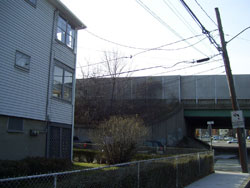

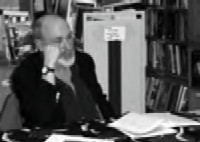
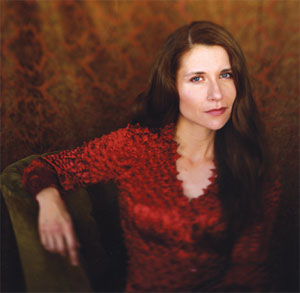
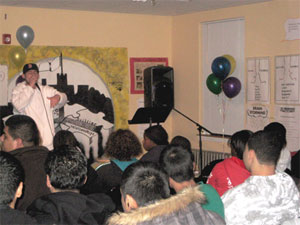
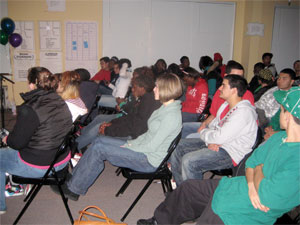
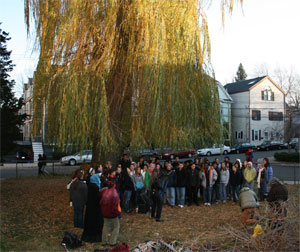
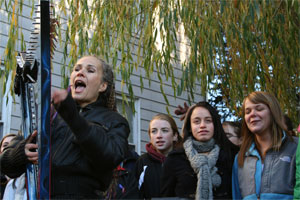
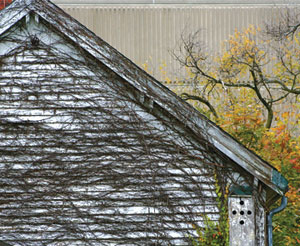
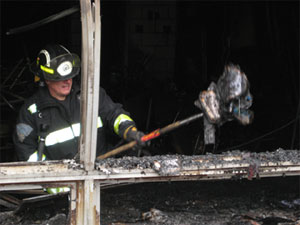
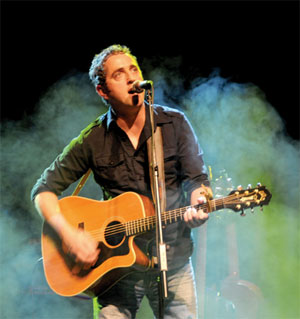
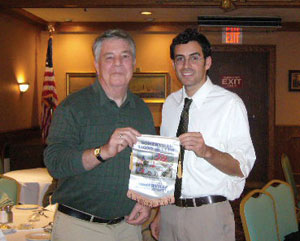














Reader Comments